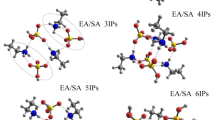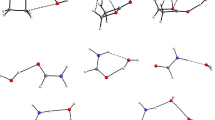Abstract
Propose
The propose is to investigate the reasons for the insolubility of Form III in water and to explore the mechanism of the hydration process of Form III.
Methods
The conformational and cohesive energies of Form III and Form H1 were calculated using Gaussian 16 and Crystal Explorer 17. Gaussian 16 and Multiwfn 3.8 was used to calculate the molecular surface electrostatic potential of Form III and Form H1 and to calculate the energies of the stronger intermolecular interactions in the crystal structure. The behaviors of Form III in water were simulated using Gromacs 2020.6. Finally, the hydration process from Form III to Form H1 was monitored in situ using Raman spectroscopy.
Results
The conformational energies of Form III and H1 are almost the same. The cohesion energy of Form H1 is much larger than that of Form III because both number of hydrogen bonds and van der Waals interactions are higher in the Form H1. During the simulation, the supercell of APZ form a supramolecular cluster. Several molecules manually dismantled from the cluster spontaneously combine to form new molecular clusters. Both increases in temperature and external energy input accelerate the hydration process.
Conclusions
More hydrogen bonds and strong van der Waals interactions in Form H1 lead to a greater stability. The overall decrease in polarity and the strong binding effect on APZ molecule clusters due to intermolecular interactions lead to the water insolubility of Form III. The hydration process from Form III to Form H1 follows a novel, dandelion sowing-like hydration mechanism.








Similar content being viewed by others
Data Availability
The authors confirm that the data supporting the findings of this study are available within the article and its supplementary materials.
References
Hilfiker R, von Raumer, M. Polymorphism: In the Pharmaceutical Industry. Weinheim: Wiley–VCH Verlag GmbH & Co. KGaA; 2006.
Dai JY, Jia LH, Yang WC, Zhu D, Xie C, Bao Y, et al. Solid forms selection of spironolactone: Ternary phase diagram and nucleation process. Ind Eng Chem Res. 2020;59(3):1350–61.
Zheng Z, Hou B, Cheng X, Liu W, Huang X, Bao Y, et al. The mechanism of solvent-mediated desolvation transformation of lenvatinib mesylate from di-methyl sulfoxide solvate to form D. Acta Crystallogr B. 2020;76:343–52.
Wang L, Li D, Wang L, Hao H, Zhou L. Measurement and correlation of solubility and thermodynamic properties of phenacetin in 12 pure solvents from 283.15 to 323.15 K. J Chem Eng Data. 2021;66(12):4593–602.
Yu S, Hao H, Huang X, Dong Y, Liu H, Wang N. Solution thermodynamics of azlocillin sodium in four pure solvents and three binary solvent mixtures. J Mol Liq. 2021;339(1):117039.
Wang C, Rosbottom I, Turner TD, Laing S, Maloney AGP, Sheikh AY, et al. Molecular, solid-state and surface structures of the conformational polymorphic forms of ritonavir in relation to their physicochemical properties. Pharm Res-Dordr. 2021;38(6):971–90.
Li WL, Zhou LA, Tian BQ, Chen K, Feng YG, Wang T, et al. Polymorphism of Pradofloxacin: Crystal structure analysis, stability study, and phase transformation behavior. Pharm Res-Dordr. 2023;40(4):999–1012.
Young BA, Bahl D, Stevens LL. Understanding the tabletability differences between indomethacin polymorphs using powder brillouin light scattering. Pharm Res-Dordr. 2019;36(10):150.
Zhou YA, Wang JK, Xiao Y, Wang T, Huang X. The effects of polymorphism on physicochemical properties and pharmacodynamics of solid drugs. Curr Pharm Design. 2018;24(21):2375–82.
Guadalupe Sanchez-Gonzalez E, Yepez-Mulia L, Hernandez-Abad VJ, Jung CH. The influence of polymorphism on the manufacturability and in vitro dissolution of sulindac-containing hard gelatin capsules. Pharm Dev Technol. 2015;20(3):306–13.
Du YM, Wang SZ, Chen ZY, Sun SS, Zhao ZG, Li XG. Association of SLCO1B1 polymorphisms and atorvastatin safety and efficacy: A meta-analysis. Curr Pharm Des. 2018;24(34):4044–50.
Feng YG, Hao HX, Chen YQ, Wang N, Wang T, Huang X. Enhancement of crystallization process of the organic pharmaceutical molecules through high pressure. Crystals. 2022;12(3):432.
Cheng XW, Huang X, Hao YH, Wang B, Sun C, Shu JN, et al. Unveiling the role of additives in modifying crystallization behaviors of 4-(Hydroxymethyl) benzoic acid. Ind Eng Chem Res. 2022;61(20):7193–203.
Yuan MP, Wang JK, Huang X, Wang T, Wang N, Zhou LN, et al. Ultrasound-Assisted slug-flow tubular crystallization for preparation of fine ibuprofen crystals. Chem Eng Technol. 2022;45(4):727–36.
Koyama Y, Shimono S, Kishimura H, Takekiyo T, Yoshimura Y, Abe H, et al. High-pressure crystal polymorphs in 1-butyl-3-methylimidazolium perfluorobutanesulfonate. J Mol Liq. 2021;335:116415.
Thakuria R, Arhangelskis M, Eddleston MD, Chow EHH, Sarmah KK, Aldous BJ, et al. Cocrystal dissociation under controlled humidity: A case study of caffeine-glutaric acid cocrystal polymorphs. Org Process Res Dev. 2019;23(5):845–51.
Takeguchi K, Obitsu K, Hirasawa S, Orii R, Ieda S, Okada M, et al. Effect of temperature and solvent of solvent-mediated polymorph transformation on ASP3026 Polymorphs and Scale-up. Org Process Res Dev. 2016;20(5):970–6.
Yao X, Wu YF, Sun SJ, Ren FZ, Yang SP, Liu Y. The transformation relationship between two hydrates of calcium dobesilate and its application in crystallization process. Cryst Res Technol. 2020;55(12):2000139.
Zhang Q, Mei XF. Two New polymorphs of huperzine a obtained from different dehydration processes of one monohydrate. Cryst Growth Des. 2016;16(6):3535–42.
Liu WY, Hou BH, Huang X, Zong SY, Zheng ZX, Li SY, et al. Influence of intermolecular interactions and crystal structure on desolvation mechanisms of solvates. Cryst Eng Comm. 2021;23(19):3557–68.
Li SY, Wang T, Huang X, Zhou LN, Chen MY, Liu WY, et al. The role of water in the formation of crystal structures: a case study of valnemulin hydrochloride. Cryst Eng Comm. 2021;23(1):47–55.
Toyoshima R, Sekine A, Uekusa H. Hydration and dehydration transformation mechanism of cefaclor pseudopolymorphs acta crystallogr. Sect Found Adv. 2014;70:C1574.
Fujii K, Aoki M, Uekusa H. Solid-State hydration/dehydration of erythromycin a investigated by ab initio powder X-ray diffraction analysis: Stoichiometric and nonstoichiometric dehydrated hydrate. Cryst Growth Des. 2013;13(5):2060–6.
Ito M, Shiba R, Watanabe M, Iwao Y, Itai S, Noguchi S. Phase transitions of antibiotic clarithromycin forms I, IV and new form VII crystals. Int J Pharmaceut. 2018;547(1–2):258–64.
Gonzaga EV, Viana ALM, Viana OMMS, Doriguetto AC. Solid-State phase transition mechanism and physical-chemical study of the crystal forms of monosodium alendronate: Trihydrate versus Anhydrate. Cryst Growth Des. 2016;16(12):6891–902.
Carvalho PS, de Melo CC, Ayala AP, da Silva CCP, Ellena J. Reversible solid-state hydration/dehydration of paroxetine HBr Hemihydrate: Structural and thermochemical studies. Cryst Growth Des. 2016;16(3):1543–9.
Lee J, Kim D, Park J, Kim EE, Lah MS, Kim A. Pseudopolymorphs of LB30870, a direct thrombin inhibitor: One-dimensional solvent channel structures explain reversible hydration/dehydration. Cryst Growth Des. 2018;18(1):95–104.
Li SQ, Hu NH. Two hydrate pseudopolymorphs of thiamine pyrophosphate: a dihydrate and a trihydrate Acta Crystallogr. Sect Cryst Struct Commun. 2013;69(7):794–7.
Bordignon S, Vioglio PC, Bertoncini C, Priola E, Gobetto R, Chierotti MR. Pseudopolymorphism driven by stoichiometry and Hydrated/Anhydrous Reagents: The riveting case of methyl gallate center dot L-Proline. Cryst Growth Des. 2021;21(12):6776–85.
Prommer E. Aripiprazole: A new option in delirium. Am J Hosp Palliat Me. 2017;34(2):180–5.
Bando T, Aoki S, Kawasaki J, et al.; Otsuka Pharmaceutical Co., Ltd. Low hygroscopic aripiprazole drug substance and processes for the preparation thereof. Japan 200610006215.X. 2022.09.25.
Braun DE, Gelbrich T, Kahlenberg V, Tessadri R, Wieser J, Griesser UJ. Stability of solvates and packing systematics of nine crystal forms of the antipsychotic drug aripiprazole. Cryst Growth Des. 2009;9(2):1054–65.
Łaszcz M, Witkowska A. Studies of phase transitions in the aripiprazole solid dosage form. J Pharmaceut Biomed. 2016;117:298–303.
Glasser L, Sheppard DA. Cohesive energies and enthalpies: Complexities, Confusions, and corrections. Inorg Chem. 2016;55(14):7103–10.
Frisch MJ, Trucks GW, Schlegel HB, Scuseria GE, Robb MA, Cheeseman JR, et al. Gaussian 16, Revision B.01, Gaussian, Inc., Wallingford CT. 2016.
Tessler L, Goldberg I. Crystal structures of aripiprazole, a new anti-psychotic drug, and of its inclusion compounds with methanol, ethanol and water. Inclusion Phenom Macrocyclic Chem. 2006;55(3–4):255–61.
Mazurek J. CCDC 2151838: Experimental crystal structure determination. 2022. https://doi.org/10.5517/ccdc.csd.cc2b754x.
Grimme S, Antony J, Ehrlich S, Krieg H. A consistent and accurate ab initio parametrization of density functional dispersion correction (DFT-D) for the 94 elements H-Pu. J Chem Phys. 2010;132(15):154104.
Grimme S, Ehrlich S, Goerigk L. Effect of the damping function in dispersion corrected density functional theory. J Comput Chem. 2011;32(7):1456–65.
Spackman PR, Turner MJ, McKinnon JJ, Wolff SK, Grimwood DJ, Jayatilaka D, et al. CrystalExplorer: a program for Hirshfeld surface analysis, visualization and quantitative analysis of molecular crystals. J Appl Crystallogr. 2021;54:1006–11.
Witte J, Goldey M, Neaton JB, Head-Gordon M. Beyond energies: Geometries of nonbonded molecular complexes as metrics for assessing electronic structure approaches. J Chem Theory Comput. 2015;11(4):1481–92.
Lu T, Chen FW. Multiwfn: A multifunctional wavefunction analyzer. J Comput Chem. 2012;33(5):580–92.
Zhang J, Lu T. Efficient evaluation of electrostatic potential with computerized optimized code. Phys Chem Chem Phys. 2021;23(36):20323–8.
Liu ZY, Lu T, Chen QX. Intermolecular interaction characteristics of the all-carboatomic ring, cyclo[18]carbon: Focusing on molecular adsorption and stacking. Carbon. 2021;171:514–23.
Berendsen HJC, Grigera JR, Straatsma TP. The missing terms in effective pair potentials. J Phys Chem. 1987;91:6269–71.
Lu T. Sobtop 1.0 (dev3). 2022. http://sobereva.com/soft/Sobtop. Accessed 06 Jun 2022.
Allen AEA, Payne MC, Cole DJ. Harmonic force constants for molecular mechanics force fields via hessian matrix projection. J Chem Theory Comput. 2018;14(1):274–81.
Wang JM, Wolf RM, Caldwell JW, Kollman PA, Case DA. Development and testing of a general amber force field. J Comput Chem. 2004;25(9):1157–74.
Schauperl M, Nerenberg PS, Jang H, Wang LP, Bayly CI, Mobley DL, et al. Non-bonded force field model with advanced restrained electrostatic potential charges (RESP2). Commun Chem. 2020;3(1):1–11.
Lindorff-Larsen K, Piana S, Palmo K, Maragakis P, Klepeis JL, Dror RO, et al. Improved side-chain torsion potentials for the Amber ff99SB protein force field. Proteins Struct Funct Bioinform. 2010;78(8):1950–8.
Abraham MJ, Murtola T, Schulz R, Páll S, Smith JC, Hess B, et al. GROMACS: High performance molecular simulations through multi-level parallelism from laptops to supercomputers. SoftwareX. 2015;1–2:19–25.
Brittain HG. Aripiprazole: polymorphs and solvatomorphs. Profiles Drug Subst., Excipients. Relat Methodol. 2012;37:1–29.
Elbagerma MA, Edwards HGM, Munshi T, Hargreaves MD, Matousek P, Scowen IJ. Characterization of new cocrystals by raman spectroscopy, powder X-ray diffraction, differential scanning calorimetry, and transmission raman spectroscopy. Cryst Growth Des. 2010;10(5):2360–71.
Gose T, Aitken HM, Wang Y, Lynch J, Rampersaud E, Fukuda Y, et al. The net electrostatic potential and hydration of ABCG2 affect substrate transport. Nat Commun. 2023;14:5035.
Zhai F-P, Wei H-E, Liu Y, Hu F-Y. Theoretical explanation for the pharmaceutical incompatibility through the cooperativity effect of the drug–drug intermolecular interactions in the phenobarbital∙∙∙paracetamol∙∙∙H2O complex. J Mol Model. 2019;25:181.
Valdeavella CV, Blatt HD, Yang LQ, Pettitt BM. Hydration effects on the electrostatic potential around tuftsin. Biopolymers. 1999;50(2):133–43.
Murray JS, Politzer P. Encyclopedia of computational chemistry. New York: John Wiley & Sons; 1998.
Politzer P, Murray JS. The fundamental nature and role of the electrostatic potential in atoms and molecules. Theor Chem Acc. 2002;108(3):134–42.
Murray JS, Politzer P. The electrostatic potential: an overview. WIREs Comput Mol Sci. 2011;1(2):153–63.
Ardiana F, Lestari MLAD, Indrayanto G. Aripiprazole. Profiles Drug Subst., Excipients. Relat Methodol. 2013;38:35–85.
Bader RFW, Carroll MT, Cheeseman JR, Chang C. Properties of atoms in molecules: atomic volumes. J Am Chem Soc. 1987;109(26):7968–79.
Acknowledgements
This research was financially supported by National Natural Science Foundation of China (No. 21978201 and No. 21908159).
Author information
Authors and Affiliations
Corresponding authors
Ethics declarations
Conflicts of Interest
There are no conflicts to declare.
Additional information
Publisher's Note
Springer Nature remains neutral with regard to jurisdictional claims in published maps and institutional affiliations.
Supplementary Information
Below is the link to the electronic supplementary material.
Rights and permissions
Springer Nature or its licensor (e.g. a society or other partner) holds exclusive rights to this article under a publishing agreement with the author(s) or other rightsholder(s); author self-archiving of the accepted manuscript version of this article is solely governed by the terms of such publishing agreement and applicable law.
About this article
Cite this article
Zheng, Z., Huang, X., Wang, N. et al. Hydration Mechanism and Its Effect on the Solubility of Aripiprazole. Pharm Res 41, 113–127 (2024). https://doi.org/10.1007/s11095-023-03618-6
Received:
Accepted:
Published:
Issue Date:
DOI: https://doi.org/10.1007/s11095-023-03618-6




